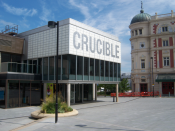CHAPTER 2: IDENTIFY THE MAIN PROBLEM(S) OR QUESTION(S)
2.1 Summary of Sheffield Theatres Trust case
This case tells us the history of two theatres, namely the Crucible and the Lyceum theatre, from the year 1971 till 2001. The problems that occurred during development and also change of the environment will be discussed. There will be a focus on the funding part and the interests of the stakeholders, which can be related to formulating a suitable strategy for the Sheffield Theatres Trust.
The Sheffield Theatres Trust is a combination of two theatres, which have their own tradition. The first tradition mentioned is producing high quality theatre in the Crucible and the second tradition is the existence of a strong history of touring theatre in the Lyceum theatre. Establishing high quality artistic work, filling sufficient seats and working without deficits are aims, which had been a challenge for the last ten years.
The Lyceum theatre opened its doors in 1897. In 1968 it closed its doors for productions due to lack of investments and modern amenities. The Sheffield council wanted to sponsor a new theatre in 1966, so a board of trustees was selected; as a result in 1971 the new theatre "Crucible"(reflecting design of the building, and history of Sheffield's steel industry) opened its doors for the visitors (the costs were �4000). This theatre consists of two stages, one that has 980 seats and a smaller (Studio Theatre), which has 250 seats (increased up to 400 nowadays). This theatre is situated next to the Lyceum theatre. Special about this new theatre is the range of activities besides the productions. Their principle was "the more people who could be enticed through the doors for whatever purpose, the stronger the theatre going community would be" . In 1987 the Sheffield Council decided...


